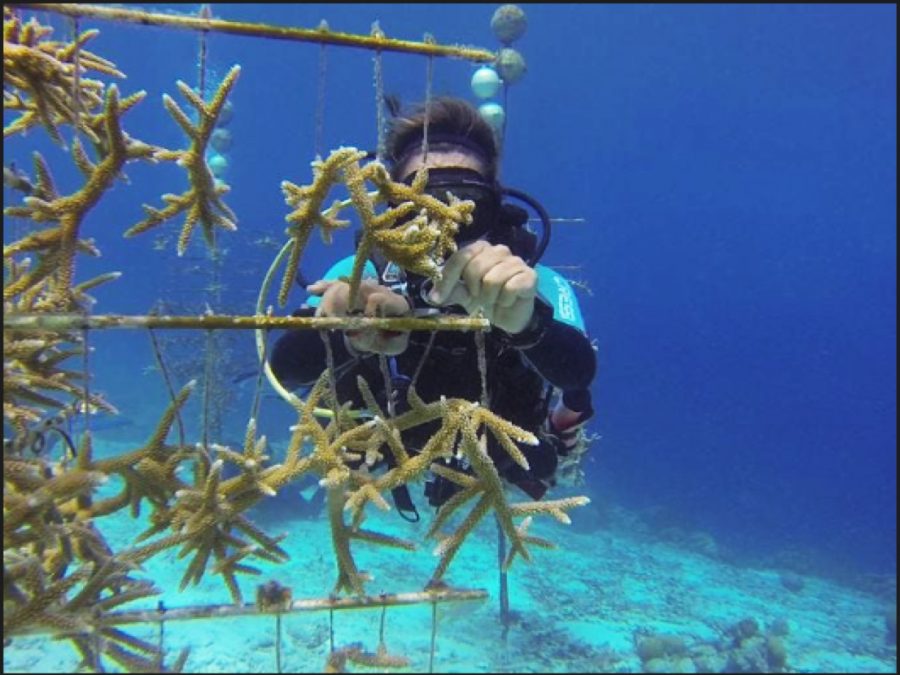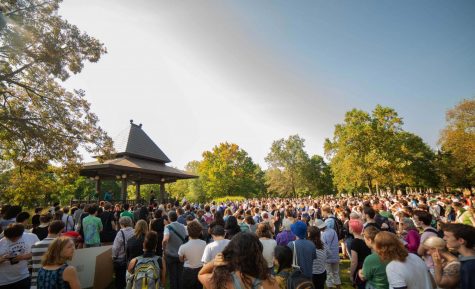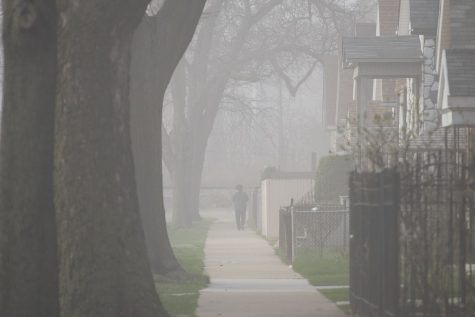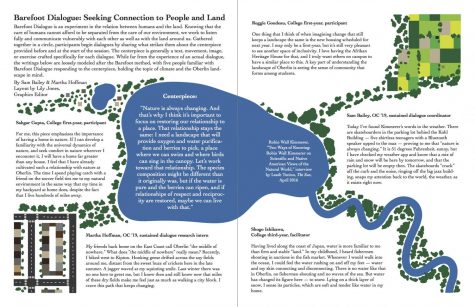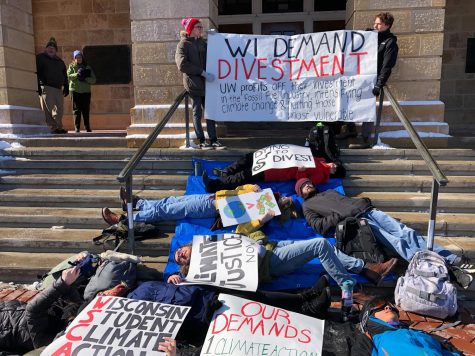The Promise of Bonaire
Courtesy of Susan Bernat, OC '97
The author SCUBA-diving near Bonaire.
I’m a certified SCUBA diver who believes that, while the ocean has no technical need for our species in its waters, divers can serve an important function as ambassadors for the ocean — in other words, keeping humans apprised of conditions underwater. As renowned oceanographer Dr. Sylvia Earle tells us, the world is blue. If there is no blue, there can be no green. Consider this: One of every two or three breaths that we take can be attributed to the oxygen production of marine microscopic phytoplankton.
The Dutch island of Bonaire lies in the southern Caribbean, a mere 50 miles off the northern coast of Venezuela. Privileged to have traveled with a SCUBA-diving group to the island in February, I recently returned to my home on the west coast of California with a renewed sense of hopefulness. In Bonaire, I received a hospitable welcome from warm people, experienced a true sense of community, and, perhaps most significantly, witnessed a population with a strong and long-established environmental vision.
People from around the globe travel to Bonaire to dive among the island’s healthy, attractive, and photogenic coral reefs, many of which are accessible from the shore. While diving along these shores, I earned a certification for reef renewal, meaning that I am certified to help repair coral reefs elsewhere on the planet.
Coral reefs are one of the most biologically diverse ecosystems on Earth. Pristine corals line the fringing reef of Bonaire during a time in which it is reported that nearly one-third of reef-building corals worldwide are threatened with extinction. Scientists predict that by the year 2050, almost all coral reefs will be in some kind of danger, and up to 75 percent of them will be critically threatened.
Specific threats include coral bleaching, caused by climate change-induced ocean warming; ocean acidification, which prevents shell-building marine organisms from producing shells for protection; pollution in the form of industrial and agricultural runoff as well as plastic contamination; and destructive fishing methods that obliterate entire reef systems.
The Bonaire National Marine Park is protected under Stichting Nationale Parken — commonly known as STINAPA — which was founded in 1962 to protect nature in the former Netherlands Antilles. Today, visitors to Bonaire benefit from the enduring work of organizations like Sea Turtle Conservation Bonaire, as the island is home to three of the world’s six endangered or critically endangered species of marine turtles. Reef Renewal Bonaire has established coral nurseries near shore, where divers maintain healthy staghorn and elkhorn plantings that are eventually transplanted to damaged reefs. The Queen Conch Restoration Project works to prevent overfishing of this marine invertebrate through educating the local population.
In 1969, Washington Slagbaai National Park was designated on land. Today, visitors to Bonaire may witness iguanas, lizards, land snails, 210 known bird species, and eight species of bats! Echo Bonaire protects the yellow-shouldered Amazon parrot by reducing poaching of chicks for the pet trade and restoring the parrots’ dry forest habitat. The Flamingo Reserve safeguards Bonaire’s signature bird by protecting its special breeding ground among the island’s saltpans.
Through the Reef Renewal Foundation, Bonaire has become a model for other islands with failing reef ecosystems. This island enforces strict regulations with regard to tourism through laws and policies that were developed decades ago, proving that, even with an increasing number of island visitors, good management and oversight can indeed protect and conserve a vast marine ecosystem.
Following are a few examples of this strictly enforced oversight. Neither divers nor snorkelers may wear gloves while underwater, thereby precluding any temptation to handle living corals. No marine creatures — dead or alive — or shells may be removed from the waters around the island; if a marine creature besides a coral polyp is handled, it must be promptly returned to its original spot. Passengers disembarking from cruise ships may remain on the island only during the day and must return to their ship by nightfall, thereby preventing island overcrowding and any residual effects on marine ecosystems. Boat anchoring is forbidden inside the Bonaire National Marine Park; mooring buoys are provided. Spearfishing and building campfires on the beach are both prohibited.
We live in perilous times for all life on our planet. Yet the pristine reefs of Bonaire are visible testimony to a community that cares deeply about its island home, and eloquent proof that when our species values an ecosystem properly, we are quite capable of preserving it.
My appreciation for these efforts harkens back to my student days on Oberlin’s campus, when I was introduced to the field of environmental studies in the Environment and Society course taught by Paul Sears Distinguished Professor of Environmental Studies and Politics Emeritus David Orr. That class changed my worldview, as I slowly began to appreciate the gifts of Nature, to observe Her more closely, and to understand that our species is not only a part of Her, but dependent upon Her.
This new vision led to a latent interest in science — in my case, marine science, fascination with ecosystems, love for nature photography, and an abiding interest in environmental issues at large. It was at Oberlin that I first learned about a sense of place and how a feeling of belonging and rootedness in a place has the power to shape one’s life. It was from David Orr that I learned everything is connected.
Connection and a sense of place are gifts from the Bonairean people to every individual fortunate enough to visit their shores. And this diver believes it’s worth the trip there just to experience harmony among all species, including our own.


